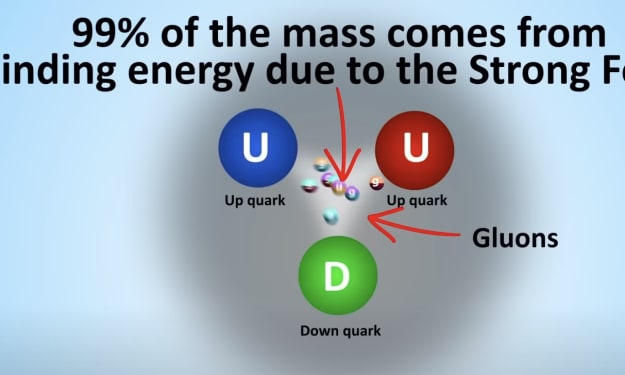
The transcript discusses the relationship between mass and energy, which is the most ubiquitous equation in all pop science. The concept that energy is equivalent to mass can be difficult to grasp because it is challenging to reconcile how something abstract, such as electricity or heat, can be the same as something tangible, such as a dumbbell or a Crunchwrap.
The transcript aims to explain this concept by starting with a broad picture of particles. Particles are excitations in Quantum Fields, and the intensity of excitation is what we refer to as energy. As particles are also waves, when they move around, they possess more energy. When comparing two particles, it doesn't make sense to compare their energy when they are moving around. So, they must be stopped or caught up with and put into the same frame of reference so that they appear motionless. Now, we can see how much energy they have. In fact, the masses of particles are the amount of energy that particle possesses at rest or in the same frame of reference as the observer. Mass is, therefore, motionless energy.
When we move to a larger scale from particles, we have to slightly modify the phrase and definition of mass. Otherwise, it doesn't make sense how kinetic energy can contribute to mass when we say mass is the energy of particles at rest. For larger realms, we say that mass is energy confined to an arbitrary system. For example, a proton has mass because particles, such as quarks, are contained within it. We can define the arbitrary system as this volume, and suddenly, it is motionless. Now, we can measure how much energy is present within this volume, which appears to be 938 Mega electron volts. We can now say that the mass of a proton is 938 Mega electron volts.
One of the examples provided in the transcript is of a photon or light, which is pure energy and has no mass because it is never motionless. However, if we had two imaginary boxes that were white bodies theoretical matter that would absorb at zero light, and we trapped a photon inside one and closed it, then that photon would bounce around forever on the inside. If we were to measure the masses of these two boxes with the precision of a photon, we would find that the box with the photon had greater mass.
It is essential to understand that mass is energy confined to an arbitrary system. Nothing in this system is conceptually anything but waves or excitations of energy. The only difference is that their presence and interactions keep them contained in this little volume, unable to leave and do anything else. It is intriguing to note that the internal composition of protons is still contested. Evidence suggests that there could be a fourth quark, and multiple quarks continuously form and disappear.
In conclusion, the relationship between mass and energy is a fundamental concept in physics. The idea that mass is energy confined to an arbitrary system can be challenging to understand, but it is crucial to grasp to understand the workings of the universe. This concept has been explained in the transcript by discussing particles and their energy, the arbitrary systems that contain this energy, and how it leads to the mass of an object.
About the Creator
Enjoyed the story? Support the Creator.
Subscribe for free to receive all their stories in your feed. You could also pledge your support or give them a one-off tip, letting them know you appreciate their work.





Comments
There are no comments for this story
Be the first to respond and start the conversation.